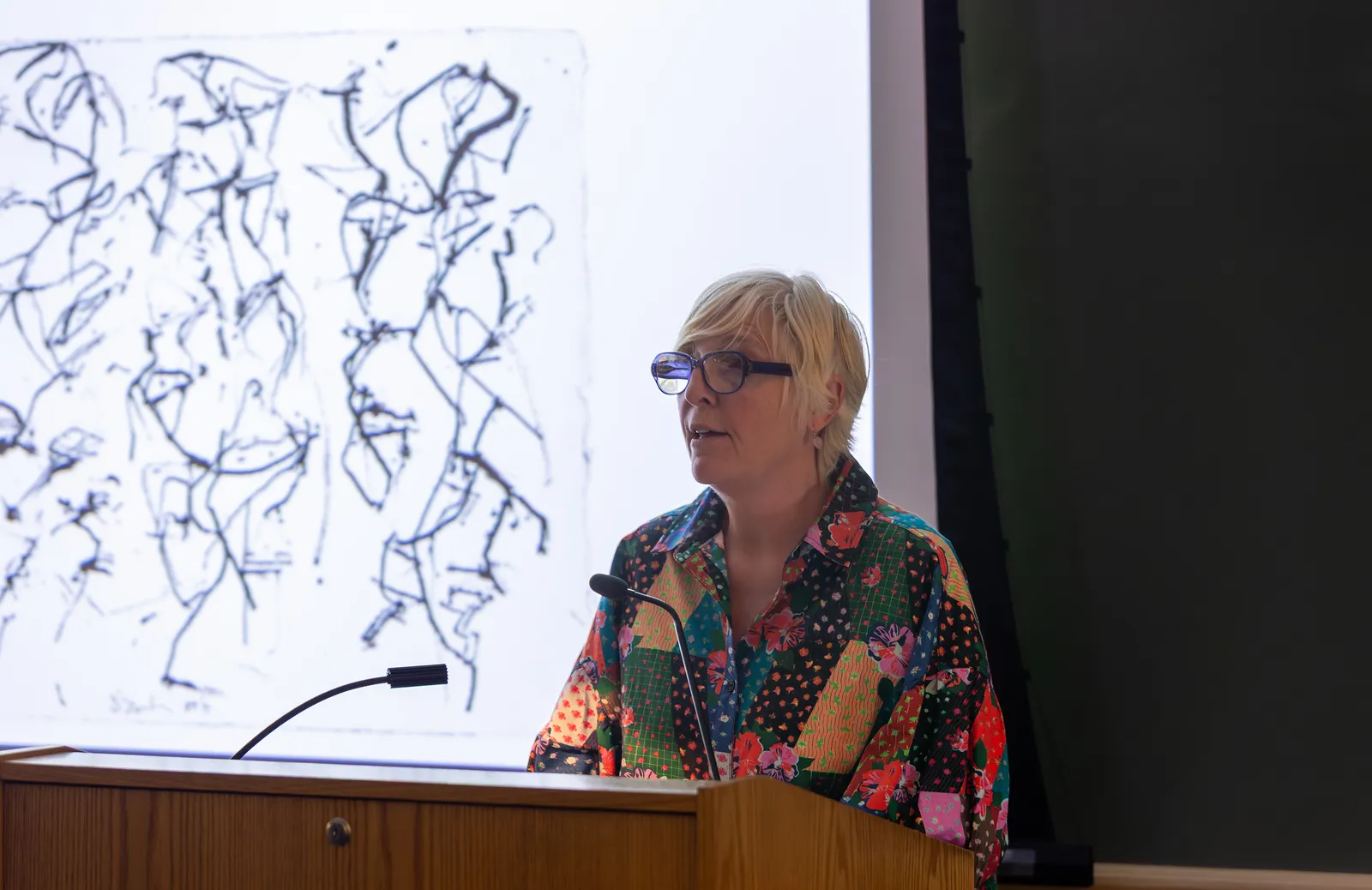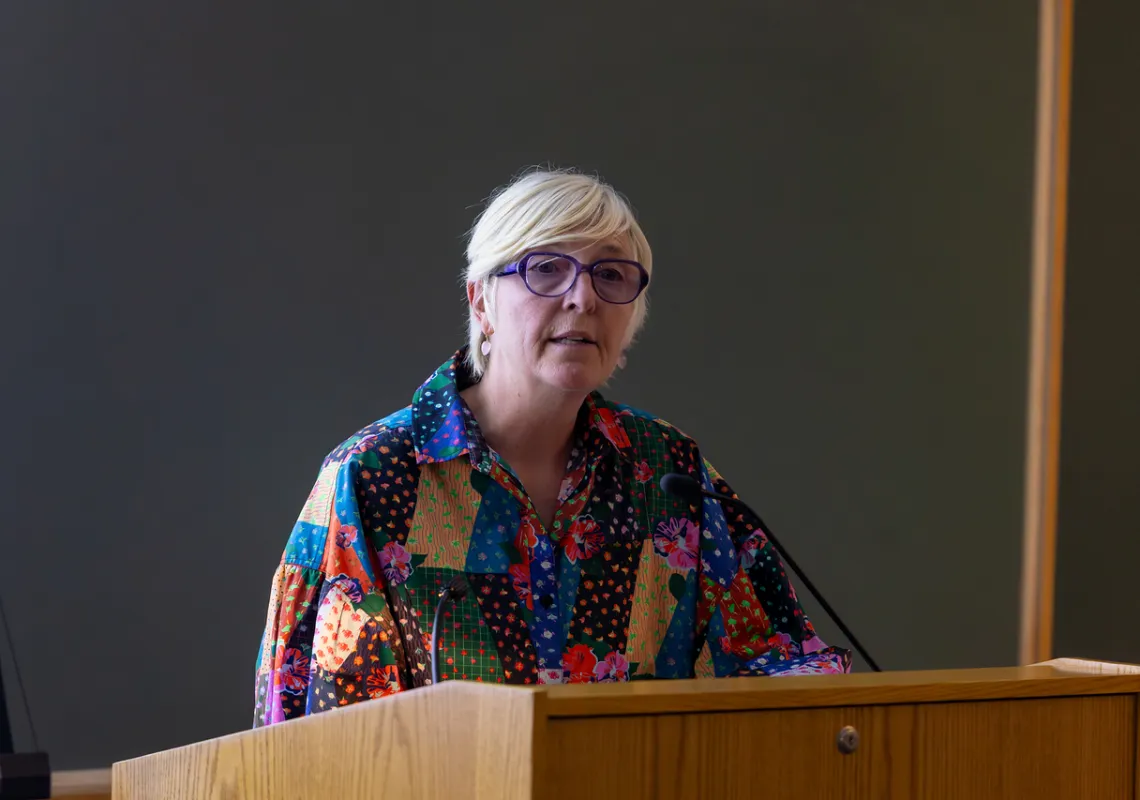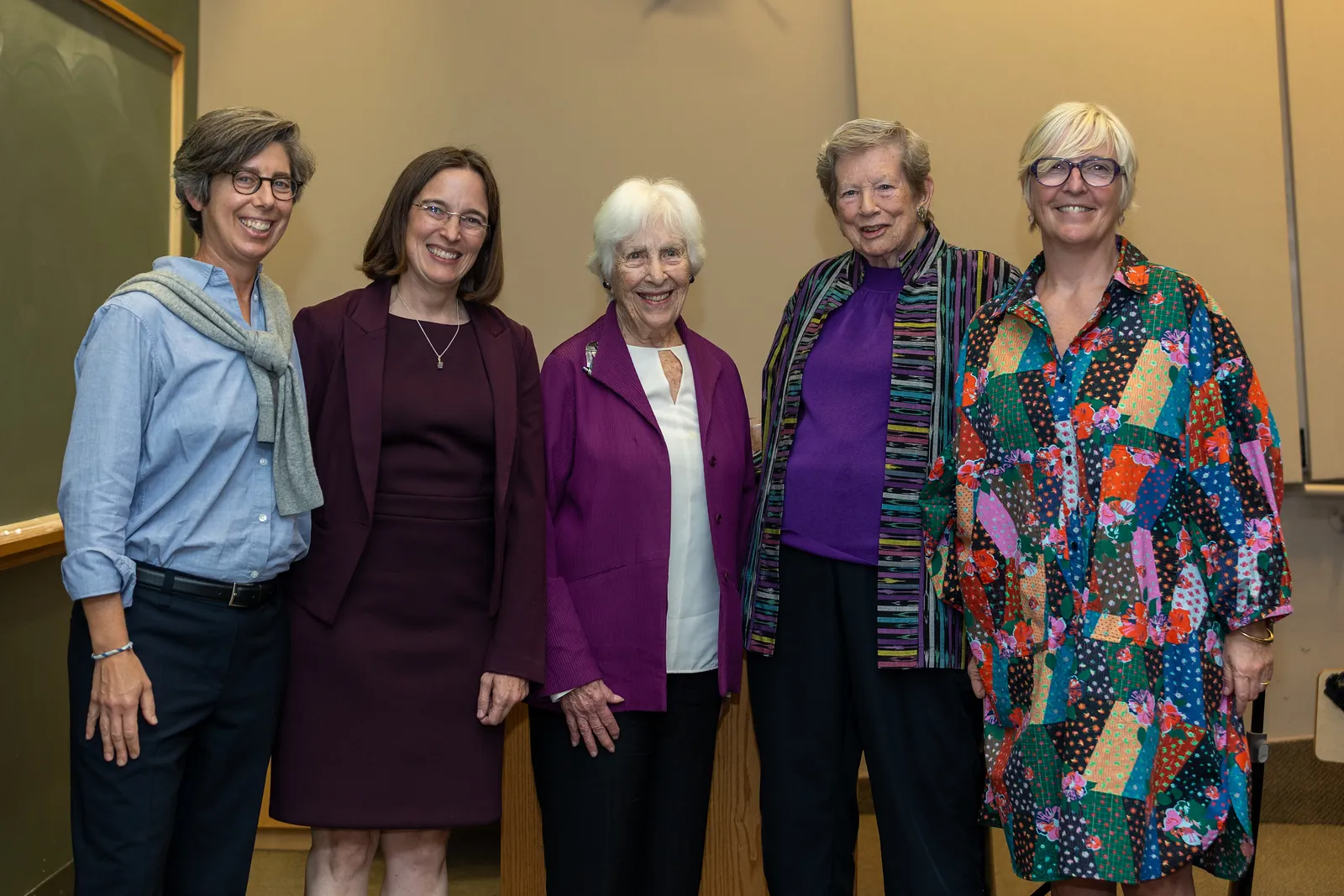
Students, faculty, alumnae, and staff packed Carpenter Library’s largest auditorium to hear a lecture by renowned curator Helen Molesworth on Monday, Sept. 29.
In her hour-long talk, Molesworth reflected on her journey from a graduate student to a curator at some of the country’s most prestigious museums. Topics included her evolution in considering audience engagement when working on an installation, the practical and philosophical challenges of museum acquisitions and installations, and the evolving role of curators in fostering care and inclusivity in museums.
The lecture was organized and introduced by Lisa Saltzman, Interim Dean of the Graduate School of Arts and Sciences and the Emily Rauh Pulitzer '55 Chair in Modern and Contemporary Art, who offered remarks and reflections on Helen's "admirably and unabashedly feminist work."
"Over the course of her career, Helen honed her voice as an eloquent interpreter and acute advocate of objects and individuals, advancing a curatorial and critical practice in which the personal and the political intertwined to produce a deeply ethical aesthetics where issues of identity are at the fore," said Saltzman in her introduction.

For a museum is many things, but first and foremost, it is an anti-death machine. Walk through the halls of the museum and everywhere the dead are whispering, clamoring to remain in the living.”
Molesworth began her talk by reflecting on her first curatorial job as curator of contemporary art at the Baltimore Museum of Art, where she learned valuable lessons early on, including when an exhibit designer kindly asked if she could make some minor adjustments to her arrangement of the pictures in her first assigned installation.
“She then proceeded to move almost every single photograph, and when she was done, the room looked literally 100 times better. I realized I had much to learn. There were tricks to this trade I had not been taught in school,” she recalled. “In my artist and academic cohort, the museum was largely understood to be a repressive institution that exerted control and domination over works of art and their ideas. The museum was a perennially bad object whose discourse of master works and genius smacked of patriarchy, whose sumptuous hallways were tainted by the problem of money, whose omnipotent narrative of perpetual progress reeked of capitalist self-satisfaction, as did its narratives of the hunt…It had not occurred to me that I only knew how to critique these stories, not how to tell a new one. I barely understood what was really happening when you hung one work of art next to another. And if the prime directive of postmodernism is that all meaning is contextual, then how was I going to produce the new contexts that enabled the new meanings?”
Molesworth soon began thinking about how she could tell a story in three dimensions and create spaces that welcomed and invited a museum’s patrons like guests in a home. She took inspiration from the work of Louise Lawler, who took subtle photos of art installed in museums, galleries, and people’s homes. Molesworth mounted the first U.S. retrospective of Lawler’s work while Chief Curator of Exhibitions at the Wexner Center for the Arts.
“The question posed by Lawler’s work was, why was the arrangement done by curators in museums more significant than the arrangements traditionally made by women in domestic space? And [I asked myself] was my newfound talent for arranging as invisible as it was, because there was so much connective tissue between what I did and what women had been doing for so long,” asked Molesworth.
In addition to doing the work many might think of as that of a museum curator — walking through galleries to do a weekly condition check of the art on view, looking at art in storage to see if it could migrate out of the vault and onto the walls, approving loan requests, and giving tours — she also found herself spending more and more time on the “night shift.”
“The night shift was the realm of cultivation,” she said.
An unexpected realization came to Molesworth at the home of a wealthy art collector on the night shift.
“Not all art was destined for museums. Not all art was well served by museums. Not all art needed a museum. A reverie during the night shift became an animating question for the day shift. What art did a museum need? This question was my gateway into the new labor of making a museum acquisition.”
Molesworth would continue to ask these questions throughout her career as she pushed boundaries and created spaces and opportunities for female, queer, and other underrepresented artists.
When she was the Curator of Contemporary Art at the Baltimore Museum of Art, she proposed that the museum acquire a version of Zoe Leonard's “Strange Fruit," a sculpture composed of sewn dry fruit skins, conceived and realized to mourn and commemorate her friend, the artist David Wojnarowicz, a victim of the AIDS crisis.
“The piece was a not-so-subtle affront to the 'save and protect' mission of the museum,” explains Moleworth. “This was a work that decidedly would not stand the test of time.”
In Leonard's s work of decay, Molesworth saw the questions that would be asked of future curators as they worked in an ever-more digital world.
“How would a curator in the future decide to document the work if one of the threads still had its needle attached, laid down before the final knot, before the darning was complete, before the women's work that is never done was done,” she asked “Would the curator of the future decide one day to exhibit just the needle when everything else was gone, would the needle survive carefully laid out in some small, precious housing, or would it be too small, too incidental, a hopelessly retrograde 20th century object…Here was a work of art that called the museum into question at its deepest existential level. For a museum is many things, but first and foremost, it is an anti-death machine. Walk through the halls of the museum, and everywhere the dead are whispering, clamoring to remain in the living.”
Prior to her lecture, Molesworth spent nearly two hours engaging in a frank, lively, and ranging conversation about her career and the art world with a group of History of Art undergraduate and graduate students.
